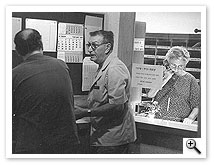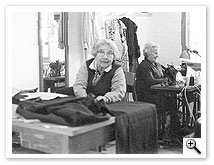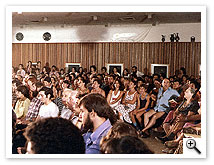There were no directors or directed. Every accepted hierarchy and rank was to be eliminated. The “members meeting” was the supreme institution – it was there that every matter was to be discussed and every decision was to be taken according to the majority opinion. The members who were elected to direct the affairs of the group had not, nor must they have, any material advantage and the weight of their opinion was not to supercede the opinion of any rank and file member. The rewards came from the satisfaction of serving and from the appreciation of everyone for the person who fills the post.
When the collective expanded and already included tens of members, there arose a need to establish the ideas on the basis of which the way of life would be maintained.
From the start there were three functions – three positions that in the beginning were performed after work hours or as part of the work day and over time became full-time jobs:
-
the secretary – head of the elected secretariat. It is he (or she) who convenes the “members meeting”, determines the agenda and is responsible for the function of commitees in charge of consumption.
-
the farm supervisor – in charge of coordination between the productive branches. Responsible for the fostering and the development of new branches. Responsible for the function of the economic and agricultural commitees.
-
the treasurer – responsible for the accounting, purchases and sales, charging for produce and paying for goods and materials consumed by the community. He (or she) is also a kind of external secretary for maintaining the ties with the institutions of the kibbutz movement and in general.
These three position-holders are elected and are also members of the secretariat by virtue of their positions.
All of the commitees and institutions are elected by the assembly, while the proposals for the commitees’ makeup are put forward by the appointments/proposals committee, which is elected by the meeting.
The length of term for each committee varies, except for the appointments committee, which is a perpetual committee – when a certain committee completes its term the appointments committee restaffs it.

The functions once performed by the assembly in debating issues that do not consist of a change in the way of life are now filled by an elected council.
The council is made up of: the position-holders in the secretariat, the human resouces manager, the manager of Toolgal (provided he is a member of Degania ‘A’), the supervisors of the food and education sectors and the health committee supervisor, ____________ and also the public representatives in the secretariat and fifteen more public representatives. Participation in all of the meetings is compulsory for all council members.
Likewise, by public demand – the position holders in the secretariat and chairmen of sensitive commitees are elected in a ballot.
Organizational structure: position-holders and commitees

 |
 |
|
Frida, Iztush and Haviv at the mail office |
Victoria and Miriam Zinger at the sewing workshop |

Up until the 1950’s all consumption of goods was on a collective basis, whereas with housing, furniture, clothing, shoes, personal items and vacation norms were set by which the members’ needs were fulfilled. In the early 1960’s the first personal budgets were alotted, which included allowances for shoes, clothing and personal items. Over time the overall budget was implemented, which in a ddition to the personal budget included the furniture allowance, painting and whitewashing and personal items.
Recently the costs of electricity, trips abroad, newspapers, repair of appliances, bicycles and watches, car trips, family occasions (weddings, bar-mitzvahs and brit-milah) and finally the food budget have been privatized. In the privatized dining room only lunch is served on weekdays and a festive meal is served on Sabbath and holiday eves. On the Sabbath and holidays the dining room is closed and the members eat lunch at home.
The kibbutz continues to maintain:
A clothing store, a laundry service which includes folding, ironing and sorting onto the members’ shelves, (and a sewing room that provides childrens clothes, bedding and repairs).
A grocery, where food products are bought and a store for items such as sweets, school supplies, dishes etc.
An electricians shop, metalwork shop, garage and bicycle repair shop – for the community and members.
A general infirmary and a dental clinic. A doctor who is in residence. Bet Yael is the old folks home.
Sports facilities: swimming pool, fitness room, tennis court, soccer field and basketball court – “Arnon Court” (in memory of Arnon Nul of blessed memory).
 |
 |
|
The dining room in a holiday |
A cultural event at the dining room |

|

